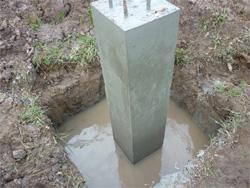Shipping Container Foundations: Part 2, Concrete Footings

Concrete footing are another option for the foundation for your used shipping container. Building concrete footings are more complex and involved than the wooden beam option, but if you're planning on keeping your container in one place for a long period of time it may be worth the investment.
Materials Needed:
- Premix Concrete - total amount depends on your geographic area
- Loose stone or gravel
- 1/4" plywood to construct the form
- 2"x2" or similar wood planks to construct the form
Using concrete footings as a foundation for your shipping or storage container falls in the middle cost range of the three options. It's cost effective, durable, but requires more time and attention when building the container foundation.
Before you being to build the concrete footing foundation for your container, you need to decide how deep the footing must be. If you live in an area with no frost this decision may not be necessary. However, if your area is prone to frost the freezing of the ground can shift your foundation and cause problems later on. The only way to prevent "frost heave" is to build your footing at least 6" below the frost line. The frost line is the maximum depth where the ground will freeze in the winter and this depth varies from 50" in North Dakota, to 0" in Florida. To learn more about the frost line in your area you can refer to the National Snow and Ice Data Center.
The second step is to decide how large your footings must be. As a general rule, one or two stacked 40' ISO containers will require 10" deep, x 20" wide, by x 20" wide (not included the extended frost footing). The chart below offers suggestions on how large your footings should be.
| Footing Size | Cubic Feet | Cubic Yards | 80lbs bags |
| 8" x 16" x 16" | 1.2 | .044 | 2 bags per footing |
| 10" X 20" X 20" | 2.3 | .086 | 3.8 bags per footing |
| 12" X 24" X 24" | 4 | .15 | 6.75 bags per footing |
The third step is to mark off the area that the storage container will take up. Measure the area out, making sure that all corners are square so that your footings are in the correct place. It's a good idea to post the area with stakes, and then tie them off so you have a strong visual idea of the size and space required.
Decide which is the highest of the four corners and begin the process here. Dig out an area wider and slightly deeper than required by the footing and compact the soil in the bottom. Follow this up by adding a 3" base of loose stone. Using the plywood and planks, construct a concrete form to the dimensions decided earlier. If you're going to reuse the same form for each footing it's better to assemble the form with screws so that it's easier to take it apart and reassemble it for each footing. Lining up the footings properly is key to this project, and the first footing will be the point from which the others are built. It's also advised to add rebar to increase the strength of your footings and prevent them from cracking. Rebar should be cut 8" longer than the depth of the hole, and driven into the ground so they are flush with the top of the footing form. The rebar should be a few inches apart in each footing, and the amount of rebar depends on the size of your footing.
Once the form is placed in the hole and the concrete poured, allow it to set for 48 hours before removing the form.
The next footing must be measured and placed based on the height of the first one. To do this accurately you'll need a laser level with which to measure the height. With the proper height and distance lined up, you're ready to pour your final three footers or more if you require the added security. Repeat the same process of digging the area out and installing the stone and concrete form, and pouring the concrete until all footers are in place.
Ideally, this should be complete several weeks before the container is due to arrive. The actual time may vary depending on the heat and humidity in your area, and it's best to ask a professional the appropriate time to allow the concrete to cure
